
STEPPING A DECK
STEPPED MAST
Here are "thumbnails" of the pictures. |
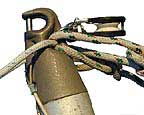 The first step is to prepare the top of the gin pole. You will need three 'shrouds' and a block to support the line which will lift the mast. This photo shows details of the top of the gin pole. The white line going to the left is the 'forestay,' and the two green lines are the aft 'shrouds.' The block is used for the 'halyard,' or mast lifting line. (Be sure you run the lifting line through this block before you stand the gin pole on end.) |
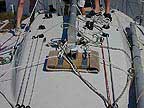 Next you need a plate to position the base of the pole . Notice that the plate is restrained from slipping to the sides by the port & starboard retaining lines, and from slipping foreword by the lines leading from the plate aft. In the case of the Antrim 27, the plate is prevented from slipping aft by a raised section for the hinge plate. To determine where to tie the mast lifting line onto the mast, lay the gin pole along side the mast aligning the bottom ends. Tie the lifting line around the mast at the height of the top of the gin pole. This will insure that when the mast is standing, the lifting line will be pulling horizontally forward (see the last picture). |
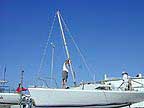 The gin pole is in place here, supported on the bottom by the above mentioned plate, and at the the top by three 'shrouds.' Notice that the pole is raked forward towards the bow so that when the mast is erect the gin pole is not in the way. The lifting line goes from the mast to the block at the top of the gin pole, then down to a turning block at the deck, then aft to a winch. |
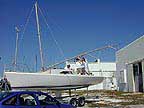 Now the mast is starting up. The weight is supported by 'lifters' and the mast lifting line. The support crew standing on the ground can make 'steering corrections' using the main halyard to guide the mast to the left or right. |
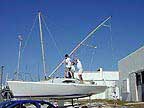 Essentially all the weight of the mast is carried by the lifting line here, while the ground support keeps the mast in line. |
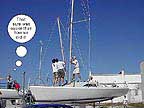 Now the mast is fully raised. Notice how the forward rake in the gin pole has kept it out of the way of the standing mast. The swept-aft spreaders and shrouds on the Antrim 27 keep the mast from falling over the bow, but if your boat has a back stay, be sure it is connected before raising the mast! The same procedure in reverse works well for lowering the rig, but it seems that two 'steering lines,' one to port and one to starboard, work better than the single steering line used when stepping the mast. This allows the ground crew to guide the mast on the way down in such a way that the corrections do not increase the downward force already on the mast. |
Copyright ©2011 Pineapple Sails
2526 Blanding Avenue
Alameda, CA 94501 USA - directions
(510) 522-2200
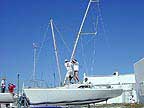 This photo-essay shows
how David Prucnal from Magothy River Sailing Association, in Pasadena, Maryland steps the mast on his Antrim
27. The plan is to use a temporary lifting pole, called a 'gin pole' to support
a 'halyard' which carries the weight of the mast so the stepping crew can spend their energy on guiding
the mast rather than lifting it. The Antrim 27 mast is 'deck stepped' on a hinge plate. The mast extrusion
is about 37 feet
long. David uses a spinnaker pole borrowed from his dad's Valiant 32, which is 15 feet long, which is 40%
of the mast length. A shorter pole would also work, but the load in the lifting line gets greater
as the pole gets shorter.
This photo-essay shows
how David Prucnal from Magothy River Sailing Association, in Pasadena, Maryland steps the mast on his Antrim
27. The plan is to use a temporary lifting pole, called a 'gin pole' to support
a 'halyard' which carries the weight of the mast so the stepping crew can spend their energy on guiding
the mast rather than lifting it. The Antrim 27 mast is 'deck stepped' on a hinge plate. The mast extrusion
is about 37 feet
long. David uses a spinnaker pole borrowed from his dad's Valiant 32, which is 15 feet long, which is 40%
of the mast length. A shorter pole would also work, but the load in the lifting line gets greater
as the pole gets shorter.